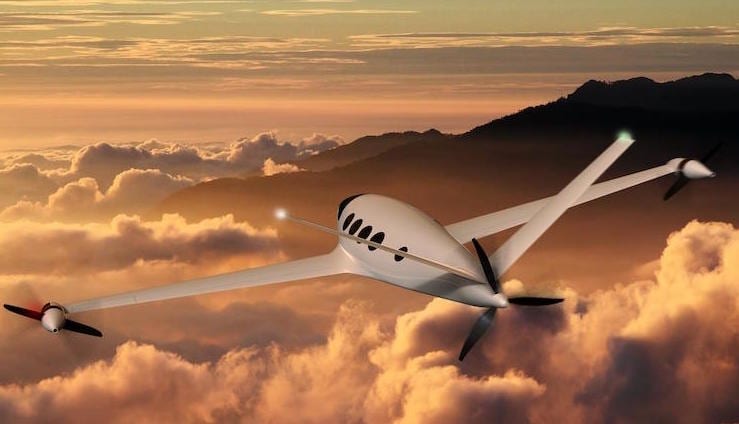
A computer rendering of Eviation’s Alice electric commuter aircraft in flight. Photo: Eviation
Eviation has established a new U.S. facility to start manufacturing and flight testing its 9-passenger electric propeller powered airplane, the Alice commuter, which the company’s chief executive told Avionics International will be ready for commercial service by 2021.
Alice is being developed as a battery powered aircraft capable of flying up to 650 miles at a cruising altitude of 10,000 feet. The aircraft is currently being assembled at the Israeli firm’s new facility in Prescott, Arizona. A first prototype of the Alice commuter will fly at the 2019 Paris Air Show.
Eviation CEO Omer Bar-Yohay said the company anticipates the beginning of its certification campaign later this year. His goal is to obtain regulatory airworthiness approval under Part 23 commuter and on-demand operations type certification requirements.
“With an IP portfolio that includes thermal management and autonomous landing, our craft faces zero regulatory hurdles. It is compliant with today’s certification requirements, and we’re in talks with a growing number of regional flight operators,” Bar-Yohay said.
South Korean battery manufacturer Kokam Co. is providing 900 kilowatt hour lithium ion battery pack for the aircraft under a $1 million supplier agreement signed with Eviation at the 2018 Singapore Airshow. Kokam was also the battery supplier for the Solar Impulse 2, which completed an around-the-globe solar-powered flight in 2016.
Harzell Propeller is providing the aircraft’s carbon fiber blades with nickel cobalt leading edges, marking the first time the company’s propellers are featured on a regional electric-powered aircraft design.

Chief Executive Officer Omer Bar-Yohay. Photo: Eviation
According to Bar-Yohay, the aircraft will need to be powered or charged with the use of an electric port that will require three hours to recharge. It also uses two wingtip-mounted pusher propellers and a tailcone propeller to fly.
In all-electric and series hybrid architectures, electrical power systems must be rated for the entire propulsive power of the airplane, which Bar-Yohay said was a focus of the Alice design team.
“Navigating the plane will be the same as a traditional jet fueled aircraft. For example, an electric aircraft has to take into consideration the same weight when it lands as when it takes off, which is no different than jet fueled counterparts which are designed to take off and land with the same full weight constraints in case of emergency,” Bar-Yohay said.
Alice is one of more than 100 different electric-powered aircraft flying or being developed at the moment, according to research into electric powered airplane technology published by German consultancy firm Roland Berger last year.
Other concepts include Pipistrel’s Alpha Electro G2 with capacity for two passengers. The Slovenian company is also designing a 19-passenger hybrid fuel cell commuter aircraft it intends to fly by 2025. Elsewhere, Boeing-backed Zunum Aero is working with Safran Helicopter Engines to develop a new-generation engine turbine to power their ZA10 electric aircraft generator.
Easyjet, Europe’s second largest commercial airline, also has a partnership with U.S.-based startup Wright Electric to develop an electric engine for a nine-seater aircraft that will take its first flight this year. The British carrier wants to start flying electric-powered passenger flights by 2027.
Eviation is currently conducting research and development on the performance of Alice as part of a partnership with Embry-Riddle Aeronautical University at their new Arizona facility. A timeline for a flight testing campaign and further details on the aircraft’s design will be released at the public unveiling of Alice in Paris.
Once certification is achieved, the Eviation CEO is targeting a $5 million price tag for Alice and an operating cost of $200 per flight hour.
“We’re still determining the primary flight operations that Alice will serve. We anticipate it will fly within routes that are most common with regional business commuters,” Bar-Yohay said.